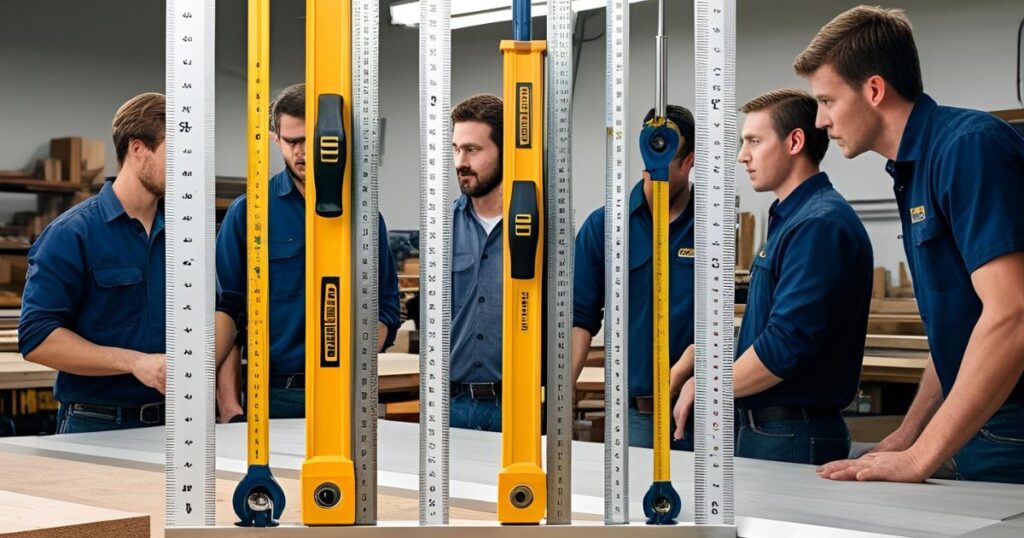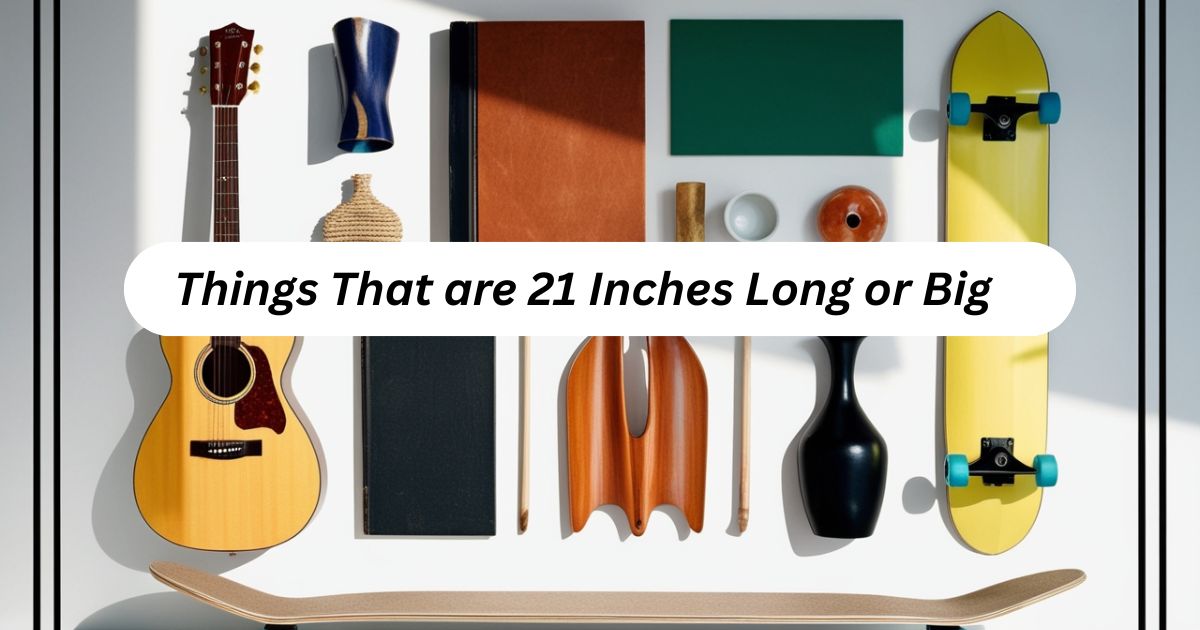Understanding 21 inches becomes essential when you need precise measurements for home improvement projects, furniture selection, or general reference purposes. This measurement represents approximately half a meter and appears frequently in manufacturing standards across multiple industries.
Professional designers, architects, and DIY enthusiasts regularly encounter this dimension in their work. The 21 inch measurement serves as a benchmark for optimal sizing in technology, construction, and design applications.
What Does 21 Inches Look Like? Understanding This Common Measurement
21 inches equals 53.34 cm or 1.75 ft, making it a substantial yet manageable length. This measurement sits just under two feet and represents the height of a small toddler or the width of standard bathroom vanities.
The dimension has become particularly significant in ergonomics and product design. Manufacturers consistently use this length because it provides an optimal balance between functionality and space efficiency. Office planners and interior design professionals frequently reference this measurement when creating efficient workspaces.
Industry standards have established 21 inches as a common benchmark across various sectors, from technology to furniture design. This standardization facilitates compatibility between products and simplifies manufacturing processes worldwide.
14 Everyday Objects That Measure 21 Inches Long

These familiar items demonstrate exactly how big is 21 inches through practical examples you encounter daily. Each object provides a reliable reference point for visualizing this important measurement.
Five Smartphones Lined Up End-to-End
Modern smartphones typically measure approximately 5.5 inches in length, making five devices placed consecutively span 21 inches. This measurement reflects the evolution of mobile device design, where manufacturers balance screen size with portability requirements.
Ergonomics plays a crucial role in determining these dimensions. Designers must consider factors like pocket compatibility and one-handed operation when establishing device sizes. The trend toward larger screens has influenced these measurements significantly, though practical limitations remain important considerations.
Understanding smartphone dimensions proves valuable for accessory manufacturers, retailers, and consumers selecting cases, holders, and other mobile-related products. This standardization has created an entire ecosystem of compatible accessories across the technology industry.
Six Standard Debit Cards Placed Consecutively
Standard debit cards maintain a universal length of 3.37 inches, making six cards placed end-to-end measure precisely 21 inches. This standardization ensures compatibility with ATMs and card readers worldwide, following ISO/IEC 7810 international banking regulations.
The specific dimensions reflect careful manufacturing considerations, balancing durability with convenience. Card holders and payment terminals worldwide rely on these consistent measurements for reliable functionality.
These measurements influence the design of wallets, card holders, and payment infrastructure, demonstrating how seemingly simple standardization affects multiple industries and daily transactions across commercial settings.
Five Traditional Men’s Wallets Stacked Vertically
Five standard men’s wallets stacked vertically reach approximately 21 inches. Each wallet typically measures 4.2 inches in height when folded, though styles may vary slightly among manufacturers.
Modern wallet design considers both functionality and fashion, accommodating standard-sized cards while maintaining comfortable pocket fit. The evolution of digital payments has influenced wallet sizes, with many trending toward slimmer profiles that consumers prefer.
Understanding these dimensions proves valuable for retailers, manufacturers, and consumers alike, particularly when designing display units or selecting appropriate storage solutions for retail environments.
Four Standard Ballpoint Pens Arranged Length-Wise
Standard writing instruments like ballpoint pens typically measure 5.5 inches in length, making four pens arranged end-to-end equal 21 inches. This length results from decades of ergonomic research and user experience studies.
Manufacturers carefully consider factors like balance, weight distribution, and grip comfort when determining optimal lengths. The standardization of pen sizes influences everything from desk organizers to briefcase designs across office environments.
These measurements affect manufacturing processes and packaging solutions, showcasing how common objects follow precise dimensional guidelines for practical reasons in commercial production.
Six Playing Cards Laid End-to-End
A standard playing card measures exactly 3.5 inches in length, making six cards laid end-to-end equal 21 inches. This standardization dates back centuries, optimized for comfortable handling and efficient storage.
Card dealers and gaming manufacturers worldwide adhere to these dimensions, ensuring consistency across different brands and games. The precise measurement allows for proper shuffling mechanics and optimal card handling during gameplay.
Professional card dealers often use this measurement knowledge for various card tricks and games, demonstrating how everyday items can serve as reliable measuring tools in entertainment and gaming industries.
Three Wine Bottles Positioned Side-by-Side
Standard wine bottles measure approximately 12 inches in height with consistent diameters across varieties. Three bottles positioned side-by-side span roughly 21 inches, influencing wine rack designs and storage solutions.
The standardization of wine bottle dimensions dates back centuries, optimized for aging, storage, and transportation. These measurements affect everything from packaging to shipping efficiency in the wine industry.
Understanding these dimensions proves essential for collectors, restaurants, and wine enthusiasts planning storage solutions or designing cellar spaces for optimal wine preservation and organization.
Acoustic Guitar Cases at Their Widest Point
Many standard acoustic guitar cases measure approximately 21 inches across their widest point. This dimension accommodates most full-size acoustic guitars while maintaining portability for musicians.
Manufacturers design these cases considering both protection and practicality, with the 21-inch width allowing sufficient padding without excessive bulk. This standardization helps musicians and retailers with storage and transportation solutions.
The consistency in these measurements influences venue storage design and music store layouts, demonstrating how industry standards affect various aspects of musical equipment management and retail presentation.
Maximum Carry-On Luggage Width Requirements
Many airlines specify 21 inches as the maximum width for carry-on luggage. This standardization helps ensure bags fit properly in overhead compartments and under seats during air travel.
Luggage manufacturers design their products according to these specifications, creating a wide range of travel solutions that meet airline requirements. Understanding these dimensions helps travelers choose appropriate bags and avoid check-in complications.
The prevalence of this measurement in travel gear demonstrates how industry standards influence consumer product design and user convenience across the transportation sector.
Compact Bathroom Vanity Standard Width
A common width for bathroom vanities is 21 inches, particularly in smaller bathrooms or powder rooms. This dimension provides adequate storage while maintaining comfortable space flow in compact areas.
Plumbers and interior design professionals often work with these standardized measurements when planning bathroom layouts. The consistency in these dimensions allows for easier replacement and renovation projects in residential settings.
Understanding these measurements helps homeowners and contractors make informed decisions about bathroom fixtures and storage solutions, ensuring optimal use of available space in home environments.
Seven Regulation Baseballs in a Row
Seven regulation baseballs lined up create a 21-inch span. Each baseball has a diameter of approximately 3 inches, following strict manufacturing guidelines established by sports authorities.
This standardization ensures fair play across all levels of baseball, from little league to professional games. Understanding these dimensions helps players and coaches maintain proper spacing and positioning during practice drills.
The consistency in baseball sizes affects equipment design, from gloves to storage solutions, making this measurement crucial in sports equipment manufacturing and facility planning.
Two and a Half Footlong Sandwiches Combined
The iconic Subway footlong sandwiches measure exactly 12 inches, making two and a half sandwiches equal 21 inches. This measurement became a standard in fast-food marketing and portion control systems.
Understanding food dimensions helps restaurants maintain consistency and manage customer expectations. The footlong measurement has become so recognized that it serves as a common reference point for other objects in food service.
This standardization influences everything from packaging design to storage solutions in commercial kitchens, demonstrating the practical application of consistent measurements in food service operations.
Average Adult Arm Length Shoulder-to-Wrist
The average adult arm length from shoulder to wrist measures approximately 21 inches, though individual measurements vary based on height and body proportions. This natural measurement has historically influenced many standardized units.
Anthropometric data shows consistent ratios in human body measurements across populations, making arm length a reliable reference point. This understanding influences ergonomic design in various industries, from furniture to workspace equipment.
Modern designers and manufacturers still consider these natural proportions when creating products for human use, demonstrating the enduring relevance of body-based measurements in product design.
Standard 21-Inch Computer Monitor Display
A standard computer monitor measuring 21 inches diagonally has been a popular choice in both home and office settings. This size represents optimal viewing distance and screen real estate for productivity tasks.
The measurement becomes particularly relevant when considering workspace ergonomics and desk setup. Industry standards for monitor mounting systems and stands are often designed around these dimensions.
Professional designers and office planners frequently use this measurement as a baseline when creating efficient workstations that maximize both comfort and productivity in commercial environments.
Two Typical Newborn Babies Head-to-Toe
The average newborn baby measures approximately 20 inches in length, making two newborns placed head-to-toe roughly equivalent to 21 inches. This measurement represents a crucial benchmark in pediatric health assessment.
Healthcare providers use these standard measurements to evaluate newborn development and growth patterns. Understanding typical newborn dimensions helps in designing appropriate medical equipment, clothing, and care products.
These measurements influence the design of nursery furniture, infant carriers, and other baby-related products, demonstrating the practical applications of standardized dimensions in childcare and healthcare.
Understanding 21-Inch Measurement Standards Across Industries

The 21-inch measurement has become a benchmark across multiple industries, from technology to construction. Understanding these standards helps professionals and consumers make informed decisions about product selection and space planning.
Manufacturing tolerances and design implications consistently reference this dimension for specific applications. The widespread adoption demonstrates its practical value across different sectors and international markets.
This standardization facilitates compatibility between products and simplifies global manufacturing processes, making it essential knowledge for architects, designers, and craftspeople.
Professional Applications and Industry Requirements
Many building codes and design guidelines reference this dimension for specific applications in construction and design. The measurement appears frequently in residential and commercial projects where space optimization matters.
Professional designers incorporate this measurement into their plans for both residential and commercial projects. Understanding these standard dimensions helps create more efficient and harmonious spaces that meet industry standards.
The practical application extends beyond individual items to influence overall space planning and design decisions across various construction and interior design projects.
Space Planning and Design Considerations
When planning spaces or selecting products, considering 21-inch measurements can optimize functionality and space efficiency. This dimension often represents an optimal balance between usability and spatial constraints.
Architects and interior design professionals frequently incorporate this measurement into their plans for maximum effectiveness. Understanding these standard dimensions helps create spaces that accommodate both human needs and practical requirements.
The knowledge proves particularly valuable for DIY enthusiasts and craftspeople working on home improvement projects where precise measurements determine project success and functionality.
21 Inches Converted to Other Measurement Units
Understanding how to measure 21 inches in different units enhances its practical application across international contexts and various measurement systems.
| Unit of Measurement | Equivalent Value |
| Centimeters | 53.34 cm |
| Millimeters | 533.4 mm |
| Feet | 1.75 ft |
| Meters | 0.5334 m |
These conversion values prove essential for international projects and cross-cultural design work where different measurement systems are standard practice.
Quick Reference Conversion Chart
The metric equivalent of 21 inches provides important reference points for global applications. Convert 21 inches to metric units when working with international manufacturers or following European design standards.
These conversions facilitate communication between designers, architects, and manufacturers working across different measurement systems, ensuring accuracy in international projects and collaborations.
Real-World Applications of 21-Inch Dimensions
Understanding 21-inch measurements proves valuable in various real-world scenarios, from home improvement to professional settings. This length often represents optimal sizing for many household items and furniture pieces.
DIY enthusiasts and craftspeople frequently encounter this measurement when working on projects. Knowledge of common items that are 21 inches helps in quick estimation when precise measuring tools are not readily available.
The standardization of this length across multiple industries demonstrates its practical significance in product design and manufacturing processes worldwide.
Manufacturing and Product Development Impact

The 21-inch measurement has influenced product design across numerous industries. Manufacturers consider this dimension when creating everything from electronic displays to furniture pieces for optimal user experience.
Understanding standard measurements helps designers create products that integrate seamlessly with existing items. This standardization facilitates compatibility between different products and ensures consistent user experiences across various applications.
The prevalence of 21-inch measurements in everyday items reflects careful consideration of human factors, ergonomics, and practical usefulness in product design and manufacturing.
Key Takeaways About 21-Inch Measurements
The 21-inch measurement plays a significant role in daily life through various common objects and industry standards. Understanding this dimension helps in practical applications, from home improvement projects to professional contexts.
Whether measuring for renovation projects or satisfying curiosity, recognizing objects that are approximately 21 inches provides useful reference points. This knowledge enhances understanding of standardized measurements and their practical applications across industries.
Remember that these measurements, while standardized, may have slight variations based on manufacturing tolerances and specific use cases. Always use proper measuring tools when precise measurements are required for professional or construction applications.











